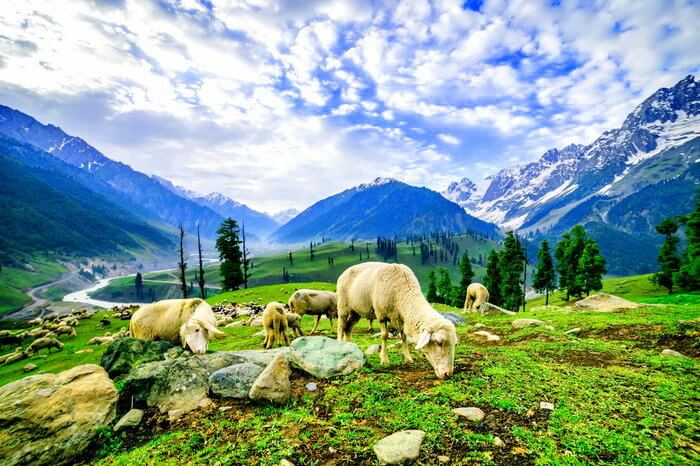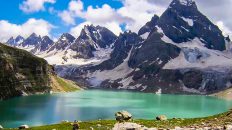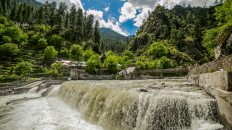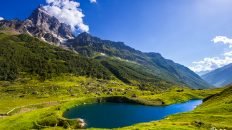Location
The State of Jammu and Kashmir is bordered in north by China, east by autonomous region of Tibet, south by Indian states of Himachal Pradesh and Punjab, and west by Pakistan. 63 per cent of the territory is under Indian occupation; while the rest, 37 per cent, is with Pakistan, called Azad (independent) Jammu and Kashmir (AJK).
Area
151,360 square kilometers
Indian-occupied Kashmir: 95,356 sq.kms
Azad Jammu and Kashmir : 56,003 sq.kms
Population
13 million (approximate)
Indian-occupied Kashmir: 7.7 million (projected figures, as census has not been held since 1991) Azad Jammu Kashmir: 2.58 million (1990 figure) Refugees in Pakistan: 1.5 million Expatriates: 1.5 million
World?s oldest dispute
The Kashmir dispute is the oldest unresolved international conflict in the world today. Pakistan considers Kashmir as its core political dispute with India. So does the international community, except India. While Indian security forces are practicing an unprecedented reign of terror in Occupied Kashmir being widely reported world-wide; the Indian government, currently led by Hindu nationalist Bharatiya Janata Party, is neither willing to negotiate the issue multilaterally?through international mediation?nor is it ready to sort it out with Pakistan through bilateral negotiations. India and Pakistan have already fought two wars over Kashmir. The exchange of fire between their forces across the Line of Control, which separates Azad Kashmir from Occupied Kashmir, is a routine affair. Now that both India and Pakistan have acquired nuclear weapons potential, the possibility of a third war between them over Kashmir, which may involve the use of nuclear weapons, cannot be ruled out. The likely nuclear disaster in South Asia, whose cause may be Kashmir, can be averted with an intervention by the international community. Such an intervention is urgently required to put an end to Indian atrocities in Occupied Kashmir and prepare the ground for the implementation of UN resolutions, which call for the holding of a plebiscite to determine the wishes of the Kashmiri people.
Cause of the Kashmir dispute
India?s forcible occupation of the State of Jammu and Kashmir in 1947 is the main cause of the dispute. India claims to have ?signed? a controversial document, the Instrument of Accession, on 26 October 1947 with the Maharaja of Kashmir, in which the Maharaja obtained India?s military help against popular insurgency. The people of Kashmir and Pakistan do not accept the Indian claim. There are doubts about the very existence of the Instrument of Accesion. The United Nations also does not consider Indian claim as legally valid: it recognises Kashmir as a disputed territory. Except India, the entire world community recognises Kashmir as a disputed territory. The fact is that all the principles on the basis of which the Indian subcontinent was partitioned by the British in 1947 justify Kashmir becoming a part of Pakistan: the State had majority Muslim population, and it not only enjoyed geographical proximity with Pakistan but also had essential economic linkages with the territories constituting Pakistan.
History of the dispute
The State of Jammu and Kashmir has historically remained independent, except in the anarchical conditions of the late 18th and first half of the 19th century, or when incorporated in the vast empires set up by the Mauryas (3rd century BC), the Mughals (16th to 18th century) and the British (mid-19th to mid-20th century). All these empires included not only present-day India and Pakistan but some other countries of the region as well. Until 1846, Kashmir was part of the Sikh empire. In that year, the British defeated the Sikhs and sold Kashmir to Gulab Singh of Jammu for Rs. 7.5 million under the Treaty of Amritsar. Gulab Singh, the Mahraja, signed a separate treaty with the British which gave him the status of an independent princely ruler of Kashmir. Gulab Singh died in 1857 and was replaced by Rambir Singh (1857-1885). Two other Marajas, Partab Singh (1885-1925) and Hari Singh (1925-1949) ruled in succession.
Gulab Singh and his successors ruled Kashmir in a tyrannical and repressive way. The people of Kashmir, nearly 80 per cent of whom were Muslims, rose against Maharaja Hari Singh?s rule. He ruthlessly crushed a mass uprising in 1931. In 1932, Sheikh Abdullah formed Kashmir?s first political party?the All Jammu & Kashmir Muslim Conference (renamed as National Conference in 1939). In 1934, the Maharaja gave way and allowed limited democracy in the form of a Legislative Assembly. However, unease with the Maharaja?s rule continued. According to the instruments of partition of India, the rulers of princely states were given the choice to freely accede to either India or Pakistan, or to remain independent. They were, however, advised to accede to the contiguous dominion, taking into consideration the geographical and ethnic issues.
In Kashmir, however, the Maharaja hesitated. The principally Muslim population, having seen the early and covert arrival of Indian troops, rebelled and things got out of the Maharaja?s hands. The people of Kashmir were demanding to join Pakistan. The Maharaja, fearing tribal warfare, eventually gave way to the Indian pressure and agreed to join India by, as India claims, ?signing? the controversial Instrument of Accession on 26 October 1947. Kashmir was provisionally accepted into the Indian Union pending a free and impartial plebiscite. This was spelled out in a letter from the Governor General of India, Lord Mountbatten, to the Maharaja on 27 October 1947. In the letter, accepting the accession, Mountbatten made it clear that the State would only be incorporated into the Indian Union after a reference had been made to the people of Kashmir. Having accepted the principle of a plebiscite, India has since obstructed all attempts at holding a plebiscite.
In 1947, India and Pakistan went to war over Kashmir. During the war, it was India which first took the Kashmir dispute to the United Nations on 1 January 1948 The following year, on 1 January 1949, the UN helped enforce ceasefire between the two countries. The ceasefire line is called the Line of Control. It was an outcome of a mutual consent by India and Pakistan that the UN Security Council (UNSC) and UN Commission for India and Pakistan (UNCIP) passed several resolutions in years following the 1947-48 war. The UNSC Resolution of 21 April 1948–one of the principal UN resolutions on Kashmir?stated that ?both India and Pakistan desire that the question of the accession of Jammu and Kashmir to India or Pakistan should be decided through the democratic method of a free and impartial plebiscite?. Subsequent UNSC Resolutions reiterated the same stand. UNCIP Resolutions of 3 August 1948 and 5 January 1949 reinforced UNSC resolutions.
Nehru?s betrayal
India?s first Prime Minister Jawaharlal Nehru made a pledge to resolve the Kashmir dispute in accordance with these resolutions. The sole criteria to settle the issue, he said, would be the ?wishes of the Kashmir people?. A pledge that Prime Minister Nehru started violating soon after the UN resolutions were passed. The Article 370, which gave ?special status? to ?Jammu and Kashmir?, was inserted in the Indian constitution. The ?Jammu and Kashmir Constituent Assembly? was created on 5 November 1951. Prime minister Nehru also signed the Delhi Agreement with the then ?ruler? of the disputed State, Sheikh Adbullah, which incorporated Article 370. In 1957, the disputed State was incorporated into the Indian Union under a new Constitution. This was done in direct contravention of resolutions of the UNSC and UNCIP and the conditions of the controversial Instrument of Accession. The said constitutional provision was rushed through by the then puppet ?State? government of Bakshi Ghulam Mohammed. The people of Kashmir were not consulted.
In 1965, India and Pakistan once again went to war over Kashmir. A cease-fire was established in September 1965. Indian Prime Minister Lal Bhadur Shastri and Pakistani president Ayub Khan signed the Tashkent Declaration on 1 January 1966. They resolved to try to end the dispute by peaceful means. Although Kashmir was not the cause of 1971 war between the two countries, a limited war did occur on the Kashmir front in December 1971. The 1971 war was followed by the signing of the Simla Accord, under which India and Pakistan are obliged to resolve the dispute through bilateral talks. Until the early 1997, India never bothered to discuss Kashmir with Pakistan even bilaterally. The direct foreign-secretaries-level talks between the two countries did resume in the start of the 1990s; but, in 1994, they collapsed. This happened because India was not ready even to accept Kashmir a dispute as such, contrary to what the Tashkent Declaration and the Simla Accord had recommended and what the UNSC and UNCIP in their resolutions had stated.
The government of Prime Minister Nawaz Sharif, after coming to power in February 1997, took the initiative of resuming the foreign secretaries-level talks with India. The process resumed in March 1997 in New Delhi. At the second round of these talks in June 1997 in Islamabad, India and Pakistan agreed to constitute a Joint Working Group on Kashmir. But soon after the talks, India backtracked from the agreement, the same way as Prime Minister Nehru had done back in the 1950s by violating his own pledge regarding the implementation of UN resolutions seeking Kashmir settlement according to, as Mr Nehru himself described, ?the wishes of the Kashmiri people.? The third round of India-Pakistan foreign secretaries-level talks was held in New Delhi in September 1997, but no progress was achieved as India continued dithering on the question of forming a Joint Working Group on Kashmir. The Hindu nationalist government of prime minister Atal Behari Vajpaee is neither ready to accept any international mediation on Kashmir, nor is it prepared to seriously negotiate the issue bilaterally with Pakistan.
Popular uprising since 1989
Since 1989, the situation in Occupied Kashmir has undergone a qualitative change. In that year, disappointed by decades-old indifference of the world community towards their just cause and threatened by growing Indian state suppression, the Kashmiri Muslim people rose in revolt against India. A popular uprising that has gained momentum with every passing day?unlike the previous two popular uprisings by Kashmiris (1947-48, first against Dogra rule and then against Indian occupation; and 1963, against Indian rule, triggered by the disappearance of Holy relic), which were of a limited scale.
The initial Indian response to the 1989 Kashmiri uprising was the imposition of Governor?s Rule in the disputed State in 1990, which was done after dissolving the government of Farooq Abdullah, the son of Sheikh Abdullah. From July 1990 to October 1996, the occupied State remained under direct Indian presidential rule. In September 1996, India stage-managed ?State Assembly? elections in Occupied Kashmir, and Farooq Abdullah assumed power in October 1996. Since then, the situation in the occupied territories has further deteriorated. Not only has the Indian military presence in the disputed land increased fundamentally, the reported incidents of killing, rape, loot and plunder of its people by Indian security forces have also quadrupled.
To crush the Kashmiri freedom movement, India has employed various means of state terrorism, including a number of draconian laws, massive counter-insurgency operations, and other oppressive measures. The draconian laws, besides several others, include the Armed Forces (Jammu and Kashmir) Special Powers Act, 1990; Terrorist and Disruptive Activities Act (TADA), 1990; the Jammu & Kashmir Public Safety Act, 1978 (amended in 1990); and the Jammu & Kashmir Disturbed Areas Act, 1990.
Most densely-soldiered territory
The Indian troops-to-Kashmiri people ratio in the occupied Kashmir is the largest ever soldiers-to-civilians ratio in the world. There are approximately 600,000 Indian military forces?including regular army, para-military troops, border security force and police?currently deployed in the occupied Kashmir. This is in addition to thousands of ?counter-militants??the civilians hired by the Indian forces to crush the uprising.
Since the start of popular uprising, thousands of innocent Kashmir people have been killed by the Indian occupation forces. There are various estimates of these killings. According to government of India estimates, the number of persons killed in Occupied Kashmir between 1989 and 1996 was 15,002. Other Indian leaders have stated a much higher figure. For instance, former Home Minister Mohammad Maqbool Dar said nearly 40,000 people were killed in the Valley ?over the past seven years.? Farooq Abdullah?s 1996 statement estimated 50,000 killings ?since the beginning of the uprising.? The All-Parties Hurriyat Conference (APHC)–which is a representative body of over a dozen Kashmiri freedom fighters? organizations also cites the same number. Estimates of world news agencies and international human rights organisations are over 20,000 killed.







Add comment